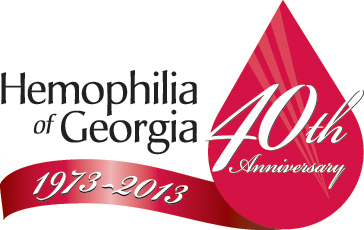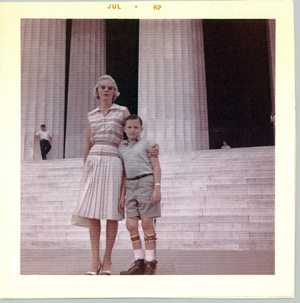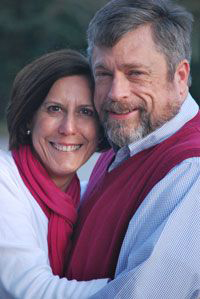An Interview with HoG Client Bob H.
Horizons in Hemophilia, March 2013
By Cathy Hulbert, LCSW, HoG Social Worker
 In celebration of Hemophilia of Georgia’s 40th anniversary, we asked Bob H. of Rome to share some insights about how hemophilia care has evolved in his lifetime. Bob, a retired middle school teacher, has seen tremendous change. His parents, William and Frances, were among the founders of Hemophilia of Georgia after his father served on the national board for years.
In celebration of Hemophilia of Georgia’s 40th anniversary, we asked Bob H. of Rome to share some insights about how hemophilia care has evolved in his lifetime. Bob, a retired middle school teacher, has seen tremendous change. His parents, William and Frances, were among the founders of Hemophilia of Georgia after his father served on the national board for years.
As an artist and professional storyteller, Bob creates vivid images of life before factor for a boy with severe Factor VIII deficiency. When he was diagnosed as a young child there was no family history of hemophilia. It was a shock. His parents were told that he would live to be about 16 years old. 
“Mother accepted the diagnosis but not the prognosis,” he said, summing up her incredible determination to move beyond the expected lifespan of 16. “To her, life was full speed ahead.” He rose to medical challenges and the expanding frontier of hemophilia care with the support of his family, friends, nurses and doctors. Blended with memories of chasing his dog -- or turning old concrete mixers in a friend’s yard into imaginary battleships -- are equally vivid memories of needles, transfusions and painful bleeds.
This world of hemophilia became the family’s new normal and they were in it together. The emphasis was on living life to the fullest. Bob smiles when he recalls that his best friend, Cliff, was his “bodyguard” in elementary school, particularly when he was in a wheelchair. Eventually Bob was hospitalized for procedures that resulted from “brainstorming sessions” by his devoted Emory doctors. The treatment included isometric exercises to straighten his bent legs. Daily plasma treatments were part of the equation. After discharge from the hospital he wore leg braces from middle school to his senior year in high school. In order to be weaned from braces Bob had to maintain an intense exercise regimen that was focused on strengthening his muscles. Bleeds could set him back. He had to be careful to guard his progress while still exercising to build his stamina.
And it paid off. Now at 62, Bob lives an active life with his wife, Beverly, and their two adult children, son-in-law, and grandson. He remains close to his mother, who lives across the street. Bob’s father is deceased but his legacy of support for his son remains. Bob’s father was an avid swimmer and an Olympic hopeful before World War II broke out. Bob grew up swimming with his family, a practice that served him well and contributed to his overall well-being.
In their decision to create a Georgia chapter of the National Hemophilia Foundation, Bob’s parents recognized the need to come together to advocate for their loved ones during a time when only whole blood transfusions were available to help someone with a serious bleed. The Red Cross provided much of the blood, but it also needed to preserve most of its blood supply for “emergencies.” So Bob’s father organized a blood drive at the Rome factory where he worked. Bob’s mother, the daughter of Emory’s chief surgeon, studied everything she could about hemophilia research and corresponded with a doctor as far away as California. Bob recalls being among the first to receive factor, thanks to his mother’s networking with researchers. “I got it the day I graduated from high school. Mother was in contact with the doctor in California who made the breakthrough. She had been writing to her for many years. This doctor literally called my mother one day and said, ‘We found it. We’ve broken the code. We know where we’re going now.’”
But in Georgia there was no organization for family support. There was no HoG. Bob’s family was among the core group who decided to get the ball rolling. They wanted to create an organization for advocacy, resources, and mutual support.
So what role does HoG fulfill that did not exist when he was a child? What did Bob’s parents and grandfather want to help create?
“Hemophilia of Georgia offers several things. First, it offers hope,” Bob said. “When I was born the life expectancy was so much shorter. I discovered in high school that I was expected to die as a teen. It was in a science book that I was reading with a friend. But I knew I was not on borrowed time. They don’t get everything right in text books. You learn to keep asking questions.”
“With HoG in existence, somebody is there when you say, ‘Help!’ Someone is there to reach back when you reach out for help.” He added that he can remember the day when HoG CEO Trish Dominic was hired. “To me, the engine was started by this core group but it wasn’t going down the tracks too far until Trish got the steam going and helped to make it what it is today. She needs to be recognized for what she has done. Trish has made this her heart and soul.”
Having seen so much growth and change, Bob is happy that young people diagnosed today do not have to deal with many of the things he experienced. But some things do remain the same. He recognizes that it is important for kids and teens to begin to own their medical care rather than relying on parents to make all of the decisions. A lack of taking responsibility can lead to feelings of powerlessness and resistance.
 “When I was 12 years old there was a Sunday afternoon and I had a knee bleed that had been going on for a while. My mother came into my room and said that I needed to go to the emergency room. I said I didn’t want to go. She surprised me when she looked at me and said, ‘Okay’ and left the room. She went back to watching television with my father. She had not done that before and it shocked me. I thought about it and I knew what I had to do. I went to Mother and said, ‘Let’s go the hospital.’ And she didn’t lecture me. She got up and we went. On that day the burden of the decision-making started to be transferred to me. That is when I began to own my own decisions about getting care. I think that’s very important if you’re going to succeed with this.”
“When I was 12 years old there was a Sunday afternoon and I had a knee bleed that had been going on for a while. My mother came into my room and said that I needed to go to the emergency room. I said I didn’t want to go. She surprised me when she looked at me and said, ‘Okay’ and left the room. She went back to watching television with my father. She had not done that before and it shocked me. I thought about it and I knew what I had to do. I went to Mother and said, ‘Let’s go the hospital.’ And she didn’t lecture me. She got up and we went. On that day the burden of the decision-making started to be transferred to me. That is when I began to own my own decisions about getting care. I think that’s very important if you’re going to succeed with this.”
Bob and his wife, also a teacher, have spent their careers helping kids learn and find their way in the world. Both have been recognized for their contributions in the educational profession. Beverly was awarded Teacher of the Year for Floyd County Schools in 2007 and Bob was honored as Teacher of the Year for Rome City Schools in 2003. Bob is also a professional storyteller and has served with the Rome Area Council for the Arts. He previously served as the adviser for the Creative Arts Society at Coosa Middle School in Rome. He taught for six years at Rome Middle School then moved to Coosa Middle School.
To talk to Bob is to hear a man who has much left to do, whether it is traveling, being with friends and family, perfecting a prized, handmade sword in his workshop, taking painting classes or sculpting angels. He describes himself as a man who is very blessed.
